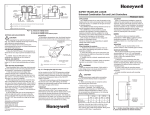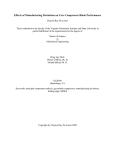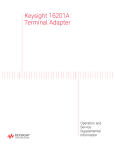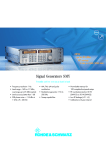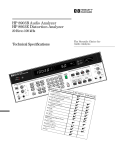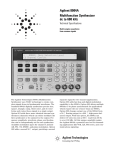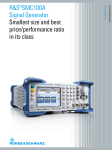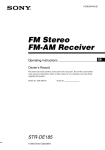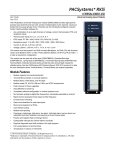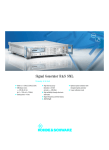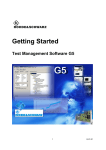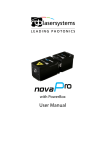Download Agilent 8657A/8657B Signal Generators
Transcript
Agilent 8657A/8657B Signal Generators Profile Spectral performance for general-purpose test Overview The Agilent Technologies 8657A and 8657B signal generators are designed to test AM, FM, and pulsed receivers as well as components. With their exceptional analog modulation, good spectral purity, and superb output level performance, these signal generators are ideal for R&D, manufacturing, and support. In-channel performance Measurement confidence The 8657A and B signal generators provide the spectral purity and modulation versatility needed for RF testing of communication and navigation equipment. Low residual FM ensures wide hum and noise test margins Hum and noise testing requires a signal generator to have low residual FM to ensure no measurement error. The residual FM of the 8657A and B provides the test margins you need for the most demanding hum and noise tests. Output level range and accuracy for sensitivity testing With a dynamic range from +13 to –143.5 dBm, the 8657A and B allow sensitivity measurements to be made on even the most sensitive receivers. The 8657A and B couple this with a level accuracy of ±1 dB (typically 0.5 dB) to –127 dBm across the full temperature range of 0 to 55 degrees C, to give you accurate and repeatable measurements every time. Low RF leakage eliminates measurement interference Sensitivity measurements can often be masked by RF leakage (radiated emissions). With the 8657A and B, RF leakage is reduced to a level that assures virtually no measurement interference. DCFM faithfully reproduces digital signals For radios with digital squelching, the 8657A and B have extremely stable dc-coupled FM (dcFM). The dc coupling of low-rate tones or digital data eliminates droop, and the exceptional stability and center-frequency accuracy when in dcFM mode eliminates the need to retune the signal generator after dcFM is selected. Pulse modulation with the 8657B High-performance pulse modulation (available on the 8657B) will give you confidence in your radar or pulsed carrier measurements. This includes rise/fall times of <35 ns, rates from dc to 30 MHz, and better than 70 dB on/off ratios (fc<1030 MHz). Out-of-channel measurements with the 8657A/B Automated tests Low single-sideband phase noise for adjacent channel selectivity testing A receiver’s ability to reject unwanted signals is measured using out-of-channel tests. With its good spectral purity, the 8657A and B make it easy to perform demanding tests such as adjacent channel selectivity measurements. Reliable output attenuators With production lines requiring ever-faster throughput, test equipment must be more reliable than ever. Output level cycling requires electromechanical relays to switch in and out of different attenuators to produce varying output levels. The 8657A and B enhance system up-time by using a very reliable attenuator technology. The 8657A is especially dependable with its electronic attenuator design. Instead of using mechanical relays for switching the attenuators, the 8657A uses solid-state components for setting output levels. The patented design uses PIN-diode switching elements with 3 million hours mean time between failure rate. This exceptional reliability is backed with a 5-year warranty against attenuator failure. Adjacent channel selectivity measures a receiver’s ability to pick out a desired signal while rejecting a strong signal one channel away. To measure adjacent channel selectivity the out-of-channel signal generator must have low single-sideband (SSB) phase noise and nonharmonic spurious content at channel spacings, otherwise the inchannel signal is masked. The exceptional phase noise performance of the 8657A and B provides a cost-effective solution for many out-of-channel tests. General purpose and component tests Output power to drive high-level inputs For applications requiring high output power, the 8657A and B can overrange beyond the +13 dBm specified output level to >+16 dBm for most frequencies. DCFM for VCO simulation State-of-the-art dcFM and wide FM bandwidth make the 8657A and B ideal sources for many VCO simulation applications. For example, the 8657A or B can be used to replace a receiver’s VCO during design. Phase adjust to characterize phase-sensitive devices The 8657A and B give you the ability to adjust the phase of the output signal in one-degree increments with respect to a source that is locked to the same reference timebase. This feature makes it easy to characterize phase-detector or phase-interferometer receivers during design or manufacturing. Manual tests 100 nonvolatile store/recall registers save set-up time The 8657A and B offer as a standard feature the ability to store 100 complete instrument states. This feature decreases set-up time when performing repetitive tests and reduces operator errors. Register sequencing provides semi-automation Stepping through the store/recall registers is easy with the front-panel sequence keys or the rear-panel remotesequence connector. These features allow the user to sequence through the storage registers in any order. 2 Ordering information Please contact your Agilent Technologies Sales and Service Office for more information or visit our website at www.agilent.com/find/tmdir Option Description 001 002 003 1BN 1BP 907 908 909 910 915 W30 W32 W34 W50 W52 W54 High-stability timebase Rear-panel connections Pulse modulation ( 8657B only) Mil std 45662A calibration certification Mil std 45622A calibration with test data Front handle kit Rack flange kit Rack flange kit w/ front handle Adds operation/calibration manual and two service manuals Adds service manual 3-year return repair service 3-year return calibration service 3-year standards compliant calibration service 5-year return repair service 5-year return calibration service 5-year standards compliant calibration service Technical specifications Output Specifications describe the instruments warranted performance and apply after a 30-minute warm-up. All specifications are valid over the signal generator’s entire operating/environment range unless otherwise noted. Range (dBm) 8657A Supplemental characteristics (indicated by italic type) are intended to provide information useful in estimating instrument capability in your application by describing typical, but not warranted, performance. Note: The upper frequency range of the 8657A is 1.04 GHz. Specifications above 1.04 GHz apply only to the 8657B. 8657B Resolution Absolute level accuracy3 8657A 8657B Frequency Range 8657A 8657B Underrange 100 kHz to 1.04 GHz 100 kHz to 2.6 GHz To 10 kHz with uncalibrated output and modulation. Resolution 8657A 8657B Accuracy and stability Switching speed1 Phase offset 10 Hz 1 Hz Same as timebase <35 ms.2 (30 ms typical at 25 °C) Output signal phase is adjustable in 1-degree nominal increments. Level flatness 100 kHz to 2.06 GHz Reverse power protection to maximum output frequency) Maximum DC voltage SWR 8657A (fc(400 kHz) 8657B Output impedance +13 dBm to –143.5 dBm into 50 Ω, +10 dBm to –143.5 dBm for frequencies from 100 kHz to 1 MHz +13 dBm to –143.5 dBm into 50 Ω, +10 dBm to –143.5 dBm with pulse modulation installed at fc<1.03 GHz 0.1 dB <±1.5 dB (>+7 dBm) <±1.0 dB (+7 to –127 dBm) <±1.5 dB (<–127 dBm) <±1.5 dB (>+3.5 dBm) <±1.0 dB (+3.5 to –127 dBm) <±1.5 dB (<–127 dBm) ±0.5 dB, output level setting of 0 dBm 50 watts (from a 50 Ω source) 8657A, 50 V 8657B, 25 V <1.5 for levels <–3.5 dBm <2.0 for levels ≤ +13 dBm <1.5 for levels ≤ –6.5 dBm <2.0 for levels ≤ +13 dBm 50 Ω nominal Internal reference oscillator Aging rate Std. (typ.) ±2 ppm/yr Temperature (0 to 55 °C) ±10 ppm Line voltage Frequency 50 MHz Timebase reference output (rear panel) External reference input (rear panel) High-stability Option 001 8657A, 1.5 x 10-8 parts/day after 10 days 1.0 x 10-9 parts/day after 180 days 8657B, 1.0 x 10-9 parts/day after 45 days 1. To be within 100 Hz of carrier frequency. 2. Add 5 ms when switching to fc>1.03 GHz for the 8657B. 3. Absolute level accuracy includes allowances for detector linearity, temperature, flatness, attenuator accuracy and measurement uncertainty. 7 x 10-9 2 x 10-9 (+5%, –10%) 10 MHz Available at a level of >0.15 Vrms into 50 Ω (output of 10, 5, or 1 MHz is selectable via internal jumper). If external reference is used, output will be the same frequency. Accepts any 10, 5, or 1 MHz ±0.002%) Frequency standard at a level >0.15 Vrms into 50 Ω 3 Spectral purity SSB phase noise (in CW mode, at 20 kHz offset) 0.1 to 130 MHz <–124 dBc/Hz (<–130 dBc/Hz, typical) 130 to 260 MHz <–136 dBc/Hz (<–140 dBc/Hz, typical) 260 to 520 MHz <–130 dBc/Hz (<–136 dBc/Hz, typical) 520 MHz to 1.04 GHz <–124 dBc/Hz (<–130 dBc/Hz, typical) 1.04 to 2.06 GHz <–118 dBc/Hz (<–123 dBc/Hz, typical) Residual FM (CW mode, rms) Frequency range Post detection BW (rms detector) 300 Hz to 3 kHz 0.1 to 130 MHz 130 to 260 MHz 260 to 520 MHz 520 MHz to1.04 GHz <4 Hz (typical <2 Hz) <1 Hz (typical <0.5 Hz) <2 Hz (typical <1 Hz) 8657A, <4 Hz (typical <1 Hz) 8657B, <3 Hz (typical <1 Hz) 1.04 to 2.06 GHz <6 Hz (typical <2 Hz) 50 Hz to 15 kHz1 <6 Hz (typical <3 Hz) <1.5 Hz (typical <1 Hz) <3 Hz (typical <1 Hz) 8657A, <6 Hz 8657B, <4 Hz (typical <1.5 Hz) <8 Hz (typical <3 Hz) 1. Typical residual FM specifications for the 50 Hz to 15 kHz post detection bandwidth apply only to the 8657B. Typical Agilent 8657A SSB phase noise at 500 MHz Typical Agilent 8657B SSB phase noise at 500 MHz 4 Residual AM (50 Hz to 15 kHz post-detection noise bandwidth, in CW mode) <0.04% AM Frequency modulation Harmonics (≤+7 dBm output levels)1 8657A 8657B 0.1 to 1.03 GHz 1.03 to 1.8 GHz 1.8 to 2.06 GHz <–30 dBc <–30 dBc <–25 dBc <–25 dBc Center frequency 0.1 to 130 MHz Subharmonics (≤+7 dBm output levels) 8657A, 8657B 0.1 to 1.03 GHz 8657B 1.03 to 1.8 GHz 1.8 to 2.06 GHz None <–40 dBc <–35 dBc Maximum FM peak deviation3 AC mode (the lesser of) 4000 x rate (Hz) or DC mode max. deviation 130 to 260 MHz 1000 x rate (Hz) or DC mode max. deviation 260 to 520 MHz 2000 x rate (Hz) or DC mode max. deviation 520 MHz to 1.04 GHz 4000 x rate (Hz) or DC mode max. deviation 1.04 to 2.06 GHz 8000 x rate (Hz) or DC mode max. deviation DC mode 8657A, 99 kHz 8657B, 200 kHz 8657A, 50 kHz 8657B, 50 kHz 8657A, 99 kHz 8657B, 100 kHz 8657A, 99 kHz 8657B, 200 kHz 8657B, 400 kHz Nonharmonics (CW mode) Frequency range 0.1 to 130 MHz Offset from carrier 5 kHz to 2 MHz 8657A, <–60 dBc 8657B, <–63 dBc (typical) 130 to 260 MHz 8657A, <–72 dBc 8657B, <–75 dBc (typical) 260 to 520 MHz 8657A, <–66 dBc 8657B, <–66 dBc (typical) 520 MHz to 1.04 GHz2 8657A, <–60 dBc 8657B, <–63 dBc (typical) 1.03 to 2.06 GHz 8657B, <–57 dBc (typical) >2 MHz Resolution 8657A <–60 dBc 8657B <–60 dBc <–60 dBc <–60 dBc <–54 dBc 100 Hz for deviations < 10 kHz; 1 kHz for deviations ≥ 10 kHz 100 Hz (200 Hz for carrier frequency >1.04 GHz) for deviations <20 kHz; 200 Hz (400 Hz for carrier frequency >1.04 GHz) for deviations >20 kHz FM rate Internal 400 Hz and 1 kHz, ±2% External (referenced to 1kHz) dc/5 Hz to 100 kHz, 3 dB bandwidth; dc/20 Hz to 50 kHz, 1 dB bandwidth 1. Spurious specifications apply for output levels ≤+4 dBm and fc<1.03 GHz when pulse modulation is installed (8657B) only. 2. 520 MHz to 1.03 GHz for 8657B. 3. FM not specified when peak deviation is >(fc –100 kHz). 5 Center frequency accuracy in dc mode Amplitude modulation Carrier frequency Center frequency accuracy Range 8657A3 0.1 to 130 MHz 130 to 260 MHz 260 to 520 MHz 520 MHz to 1.04 GHz 1.04 to 2.06 GHz ±500 Hz ±125 Hz ±250 Hz ±500 Hz ±1000 Hz Center frequency stability in dc mode <10 Hz per hour drift (typical <3 Hz per hour) Distortion (at internal rates)1 <0.5% THD plus noise (typical <1.5% for all specified deviations and rates) Sensitivity 1 Vpeak for indicated accuracy, 1 Vdc when in dc-FM mode 8657B5 Resolution Indicator accuracy (internal rates) <±5% of setting Incidental AM (peak deviations <20 kHz, internal rates) fc>500 kHz fc>1.03 GHz2 0 to 99%, level ≤+7 dBm, fc ≥400 kHz4 0 to 30%, level ≤+10 dBm, fc ≥400 kHz4 0 to 100%, level ≤+7 dBm, fc ≥400 kHz 0 to 30%, level ≤+10 dBm, fc ≥400 kHz <0.1% AM <0.5% AM 1% Rates Internal External 400 Hz and 1 kHz, ±2% 20 Hz to 40 kHz (1dB bandwidth); 8657B, typical, 20 Hz to 100 kHz (3 dB bandwidth) Distortion (internal rates, level <+7 dBm) AM depth 0 to 30% AM 31 to 70% AM 71 to 90% AM fc<1.04 GHz <1.5% <3.0% <4.0% fc>1.04 GHz 4% 4% 7% Sensitivity (typical) 1 Vpeak for indicated accuracy Indicator accuracy (for depths <90% and internal rates and levels ≤+7 dBm) Incidental phase modulation (at 30% AM depth, internal rates) <±(2% + 6% of setting) <0.3 radians peak 1. 8657A only. FM distortion only specified for deviations up to 25 kHz for 130<fc<260 MHz, and for 260<fc<520 MHz. 2. 8657B only. 3. AM depth is further limited by indicator accuracy specifications. 4. 8657A only. For fc<400 kHz, AM depths of 0 to 30%, levels ≤+7 dBm. 5. 8657B only. When pulse modulation is installed, maximum specified output level in AM is reduced by 3 dB when fc<1.03 GHz. 6 External modulation input Maximum repetition rate dc to 30 MHz, typical Front panel BNC, 600 Ω dc-coupled; front panel annunciators indicate 1 V peak signal ±5%. Level accuracy ±1.0 dB, typical Duty cycle 0 to 100%, typical (limited by rise/fall time) Pulse modulation input BNC, high impedance (internally selectable to 50 ohms), can be driven directly by TTL Maximum input level ±15 V, typical Nominal input threshold 1.6 V, typical Video feedthrough <15%, typical Modulating signal output Internal modulating signal is provided at the front panel BNC connector at nominally 1 V peak into a 600 Ω resistive load. Simultaneous modulation Internal/External Internal/Internal External/External AM/FM, FM/AM, AM/AM, FM/FM, AM/FM/(Pulse1) AM/FM AM/FM Pulse time delay2 On to off Off to on 34 ns, typical 47 ns, typical Pulse modulation (Agilent 8657B only)1 Remote programming On/off ratio fc ≥130 MHz fc ≥1.03 GHz Rise/fall times fc ≥130 MHz fc ≥1.03 GHz >70 dB >95 dB >35 ns >50 ns Interface GPIB (IEEE-488) IEEE-488 functions SH0, AH1, T0, L2, SR0, RL1, PP0, DC1, DT0, C0, E1 1. 8657B only. Pulse modulation specifications apply for carriers >130 MHz and levels ≤+7 dBm (frequency switching speed typically increases by 30 ms with pulse modulation on). Additionally, AM is unspecified with pulse modulation turned on at fc≥1.03 GHz. 2. Time delay between a change in input pulse and carrier response. 7 By internet, phone, or fax, get assistance with all your test and measurement needs. General Operating temperature range 0 to 55 °C Storage temperature range –40 to +71 °C Leakage Conducted and radiated interference is within the requirements of RE02 (and CE03 for the 8657B, except broadband conducted below 70 kHz) of MIL STD 461B, and FTZ 1046 (FTZ 1115 for 8657B). Furthermore, RF leakage of less than 1.0 µV is induced in a two-turn loop, 2.5 cm in diameter, held 2.5 cm away from the front surface. (Typical leakage for the 8657Bis <0.05 µV for levels <–40 dBm.) Online Assistance www.agilent.com/find/assist Phone or Fax United States: (tel) 1 800 452 4844 Canada: (tel) 1 877 894 4414 (fax) (905) 206 4120 Europe: (tel) (31 20) 547 2323 (fax) (31 20) 547 2390 Japan: (tel) (81) 426 56 7832 (fax) (81) 426 56 7840 Save/recall/sequence storage registers 100 non-volatile registers are available to save front panel settings. Latin America: (tel) (305) 269 7500 (fax) (305) 269 7599 Rear-panel SEQ input level TTL low to recall next storage register contents. Australia: (tel) 1 800 629 485 (fax) (61 3) 9272 0749 Power requirements 100 or 120 or 220 or 240 volts (+5%, –10% for 8657A; ±10% for 8657B) from 48 to 440 Hz; 160 VA maximum for 8657A (200 VA maximum for 8657B). IEC 1010 compliant. Weight Dimensions 8657A, net 18.2 kg (40 lb); shipping 23.6 kg (52 lb) 8657B, net 20.5 kg (45 lb); shipping 26.0 kg (57 lb) 133 mm H x 425 mm W x 574 mm D (5.25 in H x 16.75 in W x 22.6 in D) New Zealand: (tel) 0 800 738 378 (fax) (64 4) 495 8950 Asia Pacific: (tel) (852) 3197 7777 (fax) (852) 2506 9284 Product specifications and descriptions in this document subject to change without notice. Copyright © 1998, 2000 Agilent Technologies Printed in U.S.A. 8/00 5968-2704E








